StarSoldier Tactical Warfare in the 25th Century
Tags
StarSoldier is “Volume 2” of SPI’s StarForce Trilogy. Over the next few days, I’ll be going through the rule book to learn the mechanics, without getting into serious gameplay. That said, some sort of game will get played.
The first thing I like to do when looking at a new game is throw some counters on the board and push them around. The counters from Scenario 1 will do just fine.
First, which is what.
- Humans are the blue counters, and there should be 29 of them.
- L’Chal Dah are green counters, and there should be 25 of them.
Let’s dig a little deeper into the mechanics.
Fire combat
The next obvious thing (for me) is figuring out how to blow stuff up. The best way I know how to do that is put a couple of soldiers on the map and have them shoot at each other.
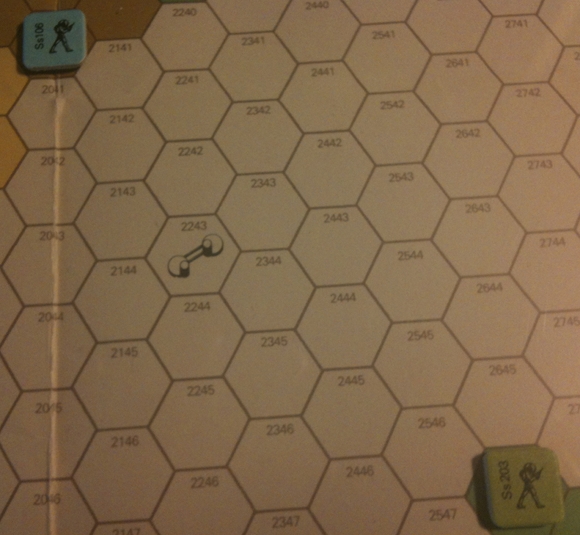
- Ss106 (SH)
| Operation | Target | TP |
| DF | 2646 | 3 |
| CM | 2 |
Attack strength = 3 x 2 = 6. Defense strength = 2RA + 2CM x 2 + 6 (terrain) = 12
- Ss203 (EE)
| Operation | Target | TP |
| DF | 2040 | 3 |
| CM | 2 |
Attack strength = 3TP x 2 = 6. Defense strength = 2RA + 2CM x 2 + 3 (organic cover) = 9.
As it turns out, AS - DS <= 0 for both units, hence, no fire.
DF stands for Direct Fire, CM for Counter Measures which will add to the effective defense strength, RA for Range Attenuation.
We’re ready to play through Scenario 1.
Scenario 1 The Epsilon Eridane Campaign
Scenario 1 is a human-human engagement pitting the Solar Hegemony against the Epsilon Eridane. The SH will be the Alpha Force, the Epsilon Eridane the Bravo force. This scenario is specified to use the Patrol Situation.
- Solar Hegemony, Alpha: 1 squad
- Epsilon Eridane, Bravo: 1 fire team, 1 heavy weapons section
Special Rules
- All urban areas treated as organic cover.
- Epsilon Eridane is allowed Orbital Ground Support, maximum per turn: * 4 Orbital Bombardment Explosives, * 2 Orbital Laser Barrages, * 2 Orbital Opcaity Bombs.
- No homing missiles for either side.
More about the Patrol Situation
In the Patrol Situation, a base is defined to exist off the east or the west edge of the map, whence the Bravo force sets up on the map and the Alpha force enters the map on the opposite side of the base.
In this case, because my game table is roughly 2’ by 3’, and I have no convenient place for record tracks, the Alpha Force (SH) will enter the north edge of the map, with the base off map to the south. The record tracks go under plexiglas on the western half of the map, leaving the eastern half for game play.
Patrol-specific Rules
Although StarSoldiers uses a simultaneous movement system, since the Bravo Force (EE) is already deployed, the first turn is the Alpha force moving on to the map. In the Patrol Situation, Alpha can only task movement (MV) and countermeasures (CM) on entry.
Alpha may enter the map in any mode.
Patrol victory conditions
- Alpha:
- 2 points for every Task Point loss in PL of Bravo force;
- 10 point for every starsoldier exited from map
- Bravo:
- 3 points for every Task Point loss on Alpha’s Preservation Level.
Setting up
Typically, I spend a lot of time setting up solitaire games so that I can get a feel for the system. Part of the setting up process often involves taking detailed notes while setting up the game, and photos and locations of units at setup.
This is in part to provide a record of what I did, in part to allow replaying the same situation exactly in the future, and in part to allow tearing the game down after the initial setup to use the table for something else. Perhaps a different game. In any case, recording the setup in detail allows play to proceed in stages. Sometimes, by the time I’ve set everything up and written it all down, I’m bored and want to examine a different game.
There is a lot of record keeping in StarSoldier, and it doesn’t look like the fun kind. I don’t necessarily have much of a problem with that, but it makes it hard to find opponents.
The first task is assigning “serial numbers” to each starsoldier such that their Task Points can be tracked.
House Rule because the map is “short,” Force Bravo will set up on the map first, and the Alpha Force will enter with 9 task points. This will allow for a positioning move, which is mostly to help me wrap my head around the mechanics. Here’s what it looks like:
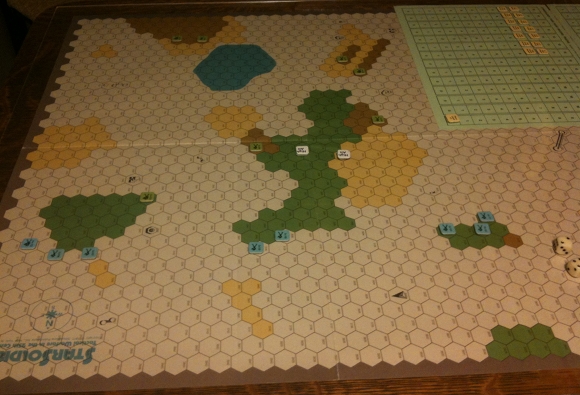
Note the star soldier record tracks are under the plexi with the counters riding on top just as the playing pieces. This is a consequence of having a very small playing area.
The actual locations are listed below:
Force Alpha (blue)
(After first “move.”)
| Track | StarSoldier | Location |
| 1 | 101 | 2927 noe |
| 2 | 102 | 3027 noe |
| 3 | 103 | 3029 noe |
| 4 | 104 | 2234 ha |
| 5 | 121 | 2137 ha |
| 6 | 105 | 3038 |
| 7 | 106 | 3140 |
| 8 | 107 | 3149 |
| 9 | 108 | 3151 |
| 10 | 122 | 3052 |
Force Bravo (green)
(Set up in advance.)
| Track | StarSoldier | Location |
| 1 | 201 | 0544 |
| 2 | 202 | 0933 |
| 3 | 203 | 1831 |
| 4 | 204 | 2140 |
| 5 | 221 | 0546 |
| 6 | 222 | 1132 |
| 7 | 223 | 2646 |
Time to play the game.
Turn 1
(November 1, 2014)
As it turns out, further reading of the rules indicates I’ve set this up as a Recon scenario rather than a Patrol scenario. My intention was to speed up the game play a bit by emplacing the EE forces. But that changes the balance of the scenario, as all the EE forces got put into defensible positions.
Another thing I intended was to provide a selection of activities for each unit on the Alpha team, then select at random. This was too much work. I don’t know the game well enough to evaluate “good” versus “bad” moves, at least anything more than staying in cover and out of the clear.
Here’s something else interesting: there is no combined fire. Each unit’s attacks are resolved one at a time.
Here’s the Solar Hegemony plan:
| StarSoldier | ER | Operation | Target |
|---|---|---|---|
| 101 | 1 | MV/4 | 2131 |
| CM/5 | |||
| 102 | 1 | MV/4 | 2231 |
| CM/5 | |||
| 103 | 1 | MV/4 | 2333 |
| CM/5 | |||
| 104 | 1 | MV/3 | 2039 |
| GD/3 | |||
| CM/3 | |||
| 121 | 1 | MV/1 | 2139 |
| GD/3 | |||
| CM/5 | |||
| 105 | 2 | NE/3 | |
| MV/6 | 2040 | ||
| 106 | 2 | NE/3 | |
| MV/6 | 1940 | ||
| 107 | 2 | MV/9 | 2752 |
| 108 | 2 | MV/9 | 2651 |
| 122 | 2 | MV/9 | 2651 |
And the Epsilon Eridani plan:
| StarSoldier | ER | Operation | Target |
|---|---|---|---|
| 201 | 2 | DF/3 | 2137 |
| CM/6 | |||
| 221 | 2 | DF/3 | 2137 |
| CM/6 | |||
| 204 | 2 | DF/3 | 2137 |
| CM/6 | |||
| 223 | 2 | DF/3 | 2137 |
| CM/6 | |||
| 202 | 2 | DF/3 | 2234 |
| CM/6 | |||
| 222 | 2 | DF/3 | 2234 |
| CM/6 | |||
| 203 | 2 | DF/3 | 2234 |
| CM/6 |
Resolving direct fire attacks
(November 2, 2014)
Computing attack factors is easy: \(AF = TP \times ER\).
Computing defense factor \(DF\) is a little more involved:
\(DF = A_T + A_R + A_M + A_{CM}\),
where \(A_T\) is the attenuation due to terrain, \(A_R\) is the attenuation due to range, \(A_M\) is the attenuation due to movement, and \(A_{CM} = CM \times ER\) is the attenuation from the target’s countermeasures.
\(AF = 6\) for all attacking units. As noted above, there is no combined fire effect in this game, attacks are resolved individually, for each unit firing. It turns out that \(DF > 6\) for all Solar Hegemony units, hence, no combat occurs.
I wrote out tables for all seven EE units firing, but the tables are too wide to fit into a browser screen. We’ll examine one combat in detail which differs mostly in range attenuation from the others.
Ss201 in hex 0544 fires on hex 2137 containing Hw121 at High Altitude with 3 TP at 2 ER for \(AF = 6\). In defense we have:
- Range 17 + 5 (HA) yields \(A_R = 3\).
- Hw121 allocated 1 TP to movement, resulting in \(A_M = 1\).
- High Altitude gives \(A_T = 1\).
- Hw121 allocated \(CM = 5\), with \(ER = 1\) because of movement, yielding \(A_{CM} = 5\).
- Total \(DF = 10\).
This results in combat differential \(\Delta = AF - DF = 6 - 10 = -4\), no combat allowed.
It looks like if I want to actually damage another unit, I’m going to have to be willing to spend enough Task Points to risk taking considerable damage myself. Devious.
Here’s the end of Turn 1:
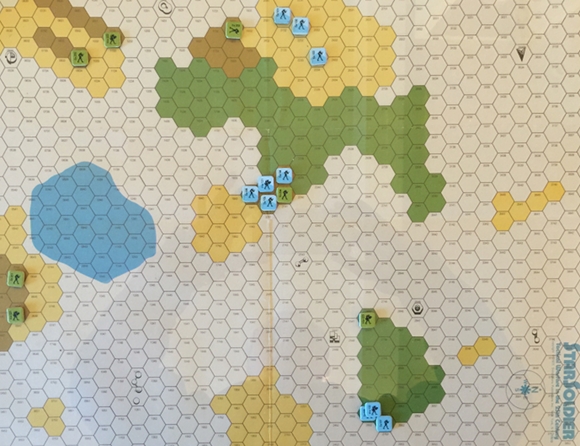
The Solar Hegemony really ought to be making a beeline for the south edge of the map, but they are staying in cover as much as possible along the way.
Score: SH 0, EE 0.
Turn 2
Keeping it simple, we’re only using single stage turns.
Plot phase
Solar Hegemony tasking:
| StarSoldier | ER | Operation | Target |
|---|---|---|---|
| 101 | 1 | MV/9 | 0340 |
| 102 | 1 | MV/9 | 0440 |
| 103 | 1 | MV/9 | 0542 |
| 104 | 1 | MV/9 | 0339 |
| 121 | 1 | MV/9 | 0239 |
| 105 | 1 | NE/9 | 0249 |
| 106 | 1 | NE/9 | 0149 |
| 107 | 2 | MV/9 | 1948 |
| 108 | 2 | MV/9 | 2050 |
| 122 | 2 | MV/9 | 1950 |
Fire phase
Launch phase
Movement phase
The clear blue dice show unit pip indictae eliminated SH units.
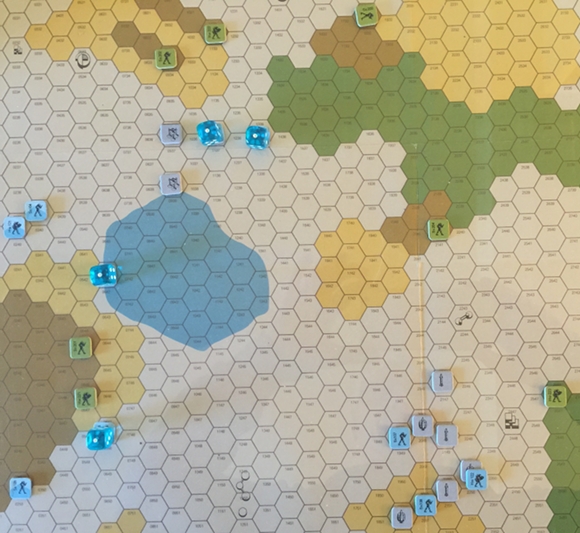
Projectile resolution phase
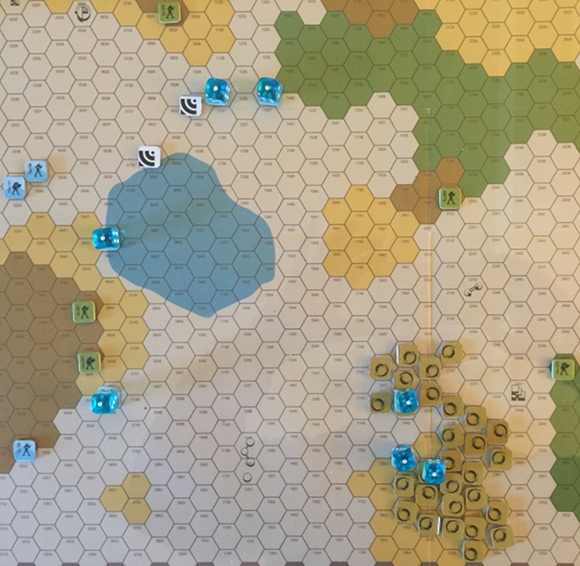
The Solar Hegemony really gets hurt. This is the consequence of allowing the EE to set up in advance on the high ground. Very difficult for the SH to hurt the EE. Also, the EE have 3 Hw units, which double the ER on direct and opportunity fire. Yikes!
Score: EE 70, SH 0.
Turn 3
Final score: EE 80, SH 20.
AAR
So far, so good. But this game could really use some decent player’s aids.
As I worked my way through Turn 1, my impression was that the rules of the game aren’t that difficult, and there aren’t that many, but the number of choices available for each unit feels large. Several kinds of movement, several types of fire, several types of weapons, all add to an excellent recipe for analysis paralysis.
These types of games are best learned either solo, or with someone at an equal level of skill. Otherwise, the more experienced player is likely to get really, really bored.
On the other hand, StarSoldier and StarForce are difficult to play solo, because the dominant mechanism in both games is the Simultaneous Movement, which induces a huge element of uncertainty difficult to recreate when playing solo. One way to get that uncertainty back is to draft two or more possible moves for each faction on each turn, then resolve the which set of moves is used at random. Easier said than done, and proved to be too much burden for the first turn.
Making a better game
Player aids:
- Record sheets similar to Starship Troopers would be much easier to handle than counters on a track.
- At least two different ledgers, one for tasking, and one for fire. The mechanisms are very simple, keeping track of what’s going on is difficult.